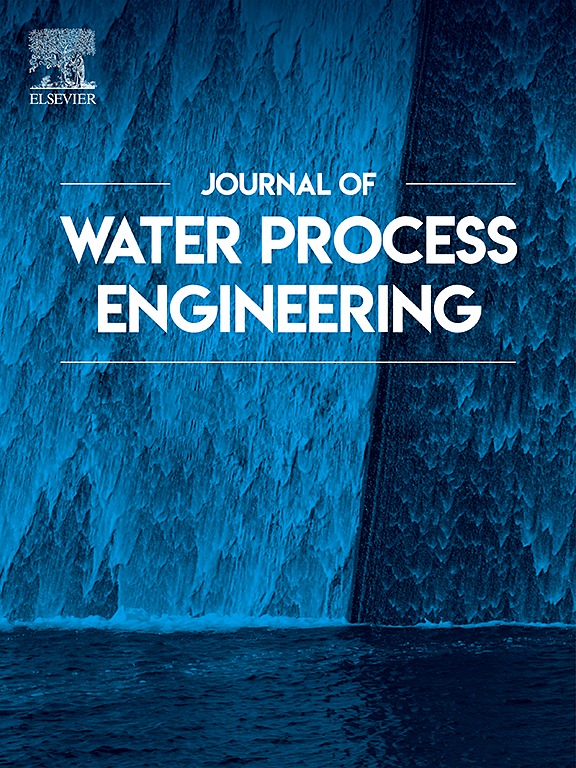植物工业废水中提取的环保活性炭在水净化中的应用:去除部分有机和无机污染物的研究
IF 6.3
2区 工程技术
Q1 ENGINEERING, CHEMICAL
引用次数: 0
摘要
从草药工业的废物进行同步热解和物理活化的二氧化碳,以获得环保吸附剂。所制得的活性炭具有比表面积发达、表面官能团浓度高、碱性官能团明显占优势的特点。所制备的吸附剂用于去除单/二元溶液中的离子聚合物(聚丙烯酸/聚乙烯亚胺)和重金属离子(Cd(II)/As(V))。研究了双电层在吸附剂作用下的结构,确定了吸附机理。结果表明,聚合物在碳质材料表面的吸附量大于金属离子。单吸附体系对聚乙烯亚胺的最大吸附量为94 mg/g,对聚丙烯酸的最大吸附量为27 mg/g,对Cd(II)的最大吸附量为8 mg/g,对As(V)的最大吸附量为4 mg/g。同时去除选定污染物的研究表明,金属离子和离子聚合物对它们的相互吸附有负面影响。此外,在含有聚丙烯酸或聚乙烯亚胺的溶液中,As(V)离子的去除被完全抑制。在pH值为3时,阴离子聚合物的存在增强了阳离子聚合物对聚乙烯亚胺的吸附,而聚丙烯酸对聚乙烯亚胺的吸附没有显著影响。本文章由计算机程序翻译,如有差异,请以英文原文为准。
Application of environmentally friendly activated carbons derived from herbal industry waste for water purification: A study on the removal of selected organic and inorganic pollutants
Waste from the herbal industry was subjected to simultaneous pyrolysis and physical activation with CO2 to obtain environmentally friendly adsorbents. The resulting activated carbons are characterized by a well-developed specific surface area and a high concentration of surface functional groups, with a distinct predomination of basic ones. The prepared adsorbents were used to remove ionic polymers (poly(acrylic acid)/polyethyleneimine) and heavy metal ions (Cd(II)/As(V)) from both single/binary solutions. The structure of the electrical double layer in the presence of adsorbates was studied to determine the adsorption mechanisms. The results showed that polymers are adsorbed in greater amounts on the surface of the carbonaceous materials than metal ions. In single-adsorbate systems, the maximum adsorption capacities were 94 mg/g for polyethyleneimine, 27 mg/g for poly(acrylic acid), 8 mg/g for Cd(II), and 4 mg/g for As(V), respectively. Studies on the simultaneous removal of selected pollutants have shown that metal ions and ionic polymers have negatively affected their mutual adsorption. Furthermore, the removal of As(V) ions from solutions containing poly(acrylic acid) or polyethyleneimine was completely inhibited. At pH 3, the adsorption of an anionic polymer was enhanced by the presence of a cationic one, whereas poly(acrylic acid) had no significant effect on polyethyleneimine adsorption.
求助全文
通过发布文献求助,成功后即可免费获取论文全文。
去求助
来源期刊

Journal of water process engineering
Biochemistry, Genetics and Molecular Biology-Biotechnology
CiteScore
10.70
自引率
8.60%
发文量
846
审稿时长
24 days
期刊介绍:
The Journal of Water Process Engineering aims to publish refereed, high-quality research papers with significant novelty and impact in all areas of the engineering of water and wastewater processing . Papers on advanced and novel treatment processes and technologies are particularly welcome. The Journal considers papers in areas such as nanotechnology and biotechnology applications in water, novel oxidation and separation processes, membrane processes (except those for desalination) , catalytic processes for the removal of water contaminants, sustainable processes, water reuse and recycling, water use and wastewater minimization, integrated/hybrid technology, process modeling of water treatment and novel treatment processes. Submissions on the subject of adsorbents, including standard measurements of adsorption kinetics and equilibrium will only be considered if there is a genuine case for novelty and contribution, for example highly novel, sustainable adsorbents and their use: papers on activated carbon-type materials derived from natural matter, or surfactant-modified clays and related minerals, would not fulfil this criterion. The Journal particularly welcomes contributions involving environmentally, economically and socially sustainable technology for water treatment, including those which are energy-efficient, with minimal or no chemical consumption, and capable of water recycling and reuse that minimizes the direct disposal of wastewater to the aquatic environment. Papers that describe novel ideas for solving issues related to water quality and availability are also welcome, as are those that show the transfer of techniques from other disciplines. The Journal will consider papers dealing with processes for various water matrices including drinking water (except desalination), domestic, urban and industrial wastewaters, in addition to their residues. It is expected that the journal will be of particular relevance to chemical and process engineers working in the field. The Journal welcomes Full Text papers, Short Communications, State-of-the-Art Reviews and Letters to Editors and Case Studies
 求助内容:
求助内容: 应助结果提醒方式:
应助结果提醒方式:


